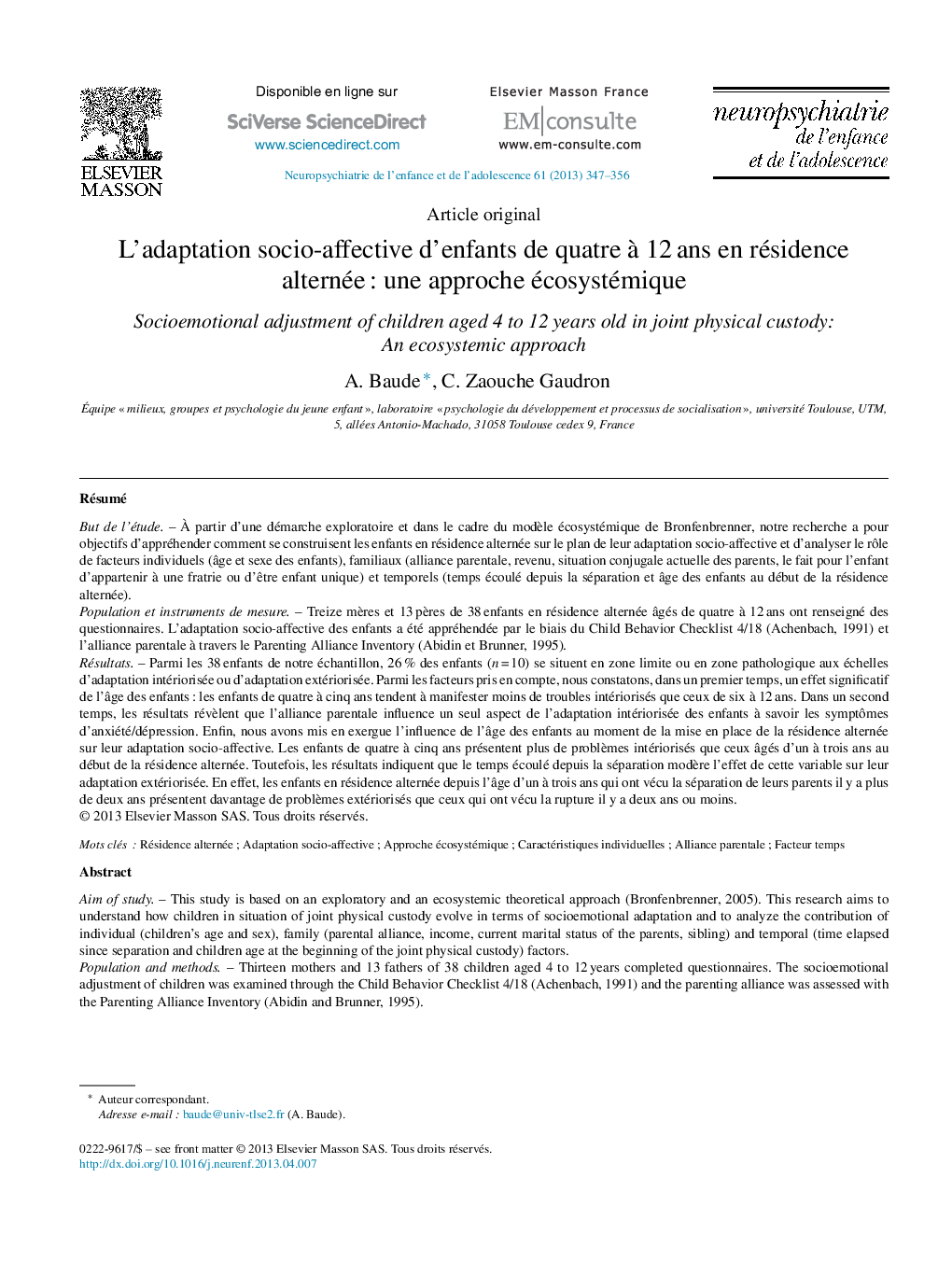| کد مقاله | کد نشریه | سال انتشار | مقاله انگلیسی | نسخه تمام متن |
|---|---|---|---|---|
| 943923 | 925572 | 2013 | 10 صفحه PDF | دانلود رایگان |

RésuméBut de l’étudeÀ partir d’une démarche exploratoire et dans le cadre du modèle écosystémique de Bronfenbrenner, notre recherche a pour objectifs d’appréhender comment se construisent les enfants en résidence alternée sur le plan de leur adaptation socio-affective et d’analyser le rôle de facteurs individuels (âge et sexe des enfants), familiaux (alliance parentale, revenu, situation conjugale actuelle des parents, le fait pour l’enfant d’appartenir à une fratrie ou d’être enfant unique) et temporels (temps écoulé depuis la séparation et âge des enfants au début de la résidence alternée).Population et instruments de mesureTreize mères et 13 pères de 38 enfants en résidence alternée âgés de quatre à 12 ans ont renseigné des questionnaires. L’adaptation socio-affective des enfants a été appréhendée par le biais du Child Behavior Checklist 4/18 (Achenbach, 1991) et l’alliance parentale à travers le Parenting Alliance Inventory (Abidin et Brunner, 1995).RésultatsParmi les 38 enfants de notre échantillon, 26 % des enfants (n = 10) se situent en zone limite ou en zone pathologique aux échelles d’adaptation intériorisée ou d’adaptation extériorisée. Parmi les facteurs pris en compte, nous constatons, dans un premier temps, un effet significatif de l’âge des enfants : les enfants de quatre à cinq ans tendent à manifester moins de troubles intériorisés que ceux de six à 12 ans. Dans un second temps, les résultats révèlent que l’alliance parentale influence un seul aspect de l’adaptation intériorisée des enfants à savoir les symptômes d’anxiété/dépression. Enfin, nous avons mis en exergue l’influence de l’âge des enfants au moment de la mise en place de la résidence alternée sur leur adaptation socio-affective. Les enfants de quatre à cinq ans présentent plus de problèmes intériorisés que ceux âgés d’un à trois ans au début de la résidence alternée. Toutefois, les résultats indiquent que le temps écoulé depuis la séparation modère l’effet de cette variable sur leur adaptation extériorisée. En effet, les enfants en résidence alternée depuis l’âge d’un à trois ans qui ont vécu la séparation de leurs parents il y a plus de deux ans présentent davantage de problèmes extériorisés que ceux qui ont vécu la rupture il y a deux ans ou moins.
Aim of studyThis study is based on an exploratory and an ecosystemic theoretical approach (Bronfenbrenner, 2005). This research aims to understand how children in situation of joint physical custody evolve in terms of socioemotional adaptation and to analyze the contribution of individual (children's age and sex), family (parental alliance, income, current marital status of the parents, sibling) and temporal (time elapsed since separation and children age at the beginning of the joint physical custody) factors.Population and methodsThirteen mothers and 13 fathers of 38 children aged 4 to 12 years completed questionnaires. The socioemotional adjustment of children was examined through the Child Behavior Checklist 4/18 (Achenbach, 1991) and the parenting alliance was assessed with the Parenting Alliance Inventory (Abidin and Brunner, 1995).ResultsAmong 38 children, 16% figure in the limit or pathological zone on the internalized adaptation, and 10% figure in the same zones assessed by the externalized adaptation scale. Among the factors taken into consideration, we note first, that there is a significant effect of children age: children between 4 to 5 years tend to show less personal internalizing problems than children between 6 to 12 years. Secondly, results reveal that the parent alliance influences only the anxiety/depressive symptoms. Finally, we show the influence of children age at the beginning of joint physical custody on their socioemotional adjustment. Children 4 to 5 years old have more internalizing problems than those aged 1 to 3 years old. However, results indicate that time elapsed since separation moderates the effect of this variable on externalized adaptation. Indeed, children in joint physical custody since the age of 1 to 3 years who have experienced parental separation more than 2 years ago have more externalizing problems than those who experienced this separation 2 years ago or less.
Journal: Neuropsychiatrie de l'Enfance et de l'Adolescence - Volume 61, Issue 6, September 2013, Pages 347–356